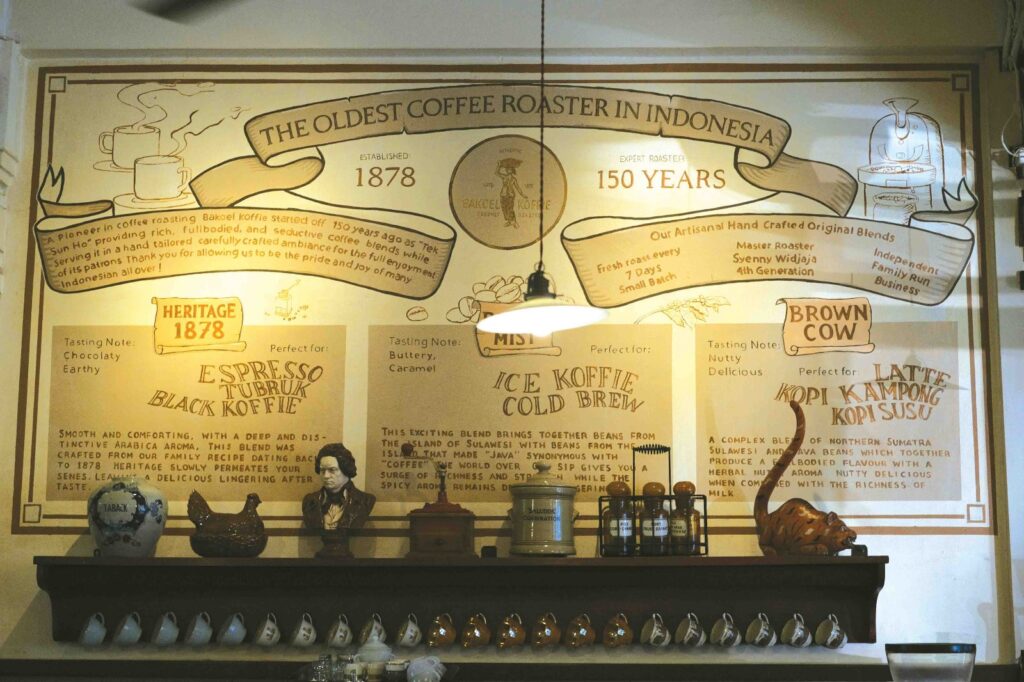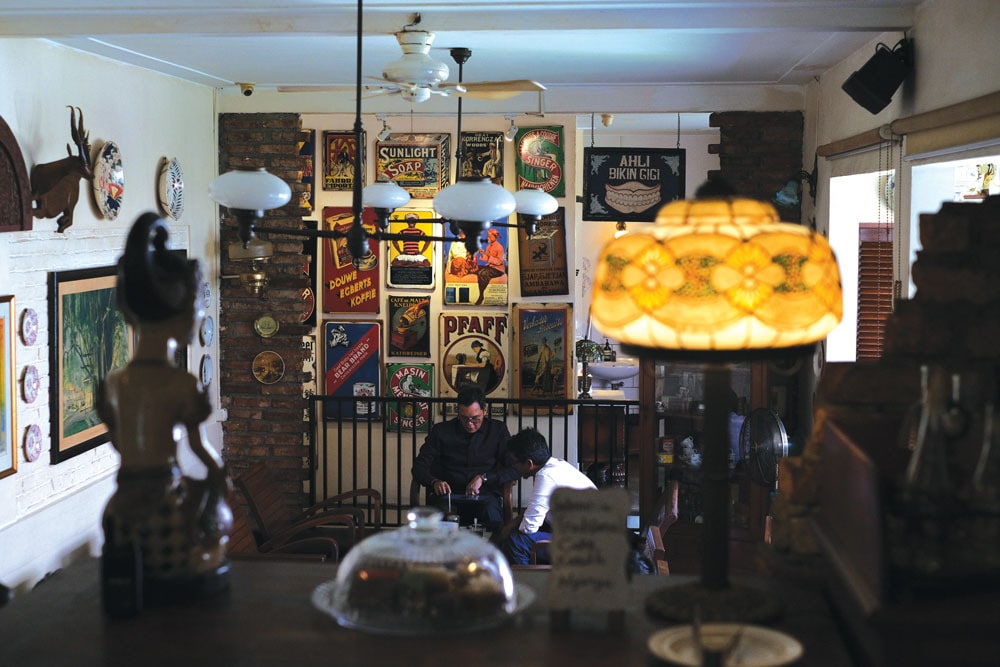
Originally built as part of Weltevreden, an elite residential area on the outskirts of Batavia, what we know now as Cikini is certainly one of Jakarta’s important historical areas. Many stories are found here, from the birth of Indonesia’s first zoo to the attempted assassination of President Soekarno. Despite experiencing rapid development, many heritage buildings and legendary sites remain, some displaying their original colonial and European architectural-style, providing a window into the past. Today, they coexist with trendy coffee shops, restaurants and newly built public spaces.
In the late 18th century, the Dutch colonial government shaped Cikini as a supporting elite residential area for Europeans settling in Nieuw Gondangdia, or Menteng, after they decided to create the Weltervreden settlement on the outskirts of Batavia. This was because Old Batavia was considered too polluted and unhealthy. Cikini was a simple plot of land on the weg naar (road leading to) Menteng, where landlords built houses for themselves.
Historical records show that during the colonial era, the land in Cikini was mostly owned by a Javanese-Arab socialite, Raden Saleh Sjarif Boestaman, Indonesia’s first maestro in classical painting better known as Raden Saleh. After travelling to major European cities and also Algeria to further his painting skills and working, Raden Saleh returned to Java and bought a large piece of land in Cikini — land which today encompasses all of Taman Ismail Marzuki (TIM), SMP Negeri 1 Cikini, to Jami’ Al Ma’mur Cikini mosque.

His love for animals and plants not only became his inspiration for his paintings. He developed part of his estate as a botanical and zoological park containing a wide variety of plants and animals. It was the first zoo in Indonesia (Dutch East Indies), initiated by Raden Saleh, named Planten en Dierentuin te Batavia (Plants and Zoo in Batavia).
Raden Saleh died on 23 April 1880, and he donated all of his Cikini land to the Dutch colonial government. The zoo area was converted into a public park, named Taman Raden Saleh, and in 1949 changed again into Cikini Zoo. As Jakarta developed, Cikini was deemed unsuitable for such a facility and the zoo was relocated to Ragunan, Pasar Minggu, in 1964. Jakarta’s first governor, Ali Sadikin, then transformed the Cikini Zoo land into what is now Taman Ismail Marzuki (TIM), one of Jakarta’s central destinations for arts, culture and education, encompassing Institut Kesenian Jakarta (IKJ), or the Jakarta Institute of Arts; as well as the newly renovated Jakarta Library (Perpustakaan Jakarta), designed by renowned Indonesian architect, Andra Matin.



One of the most treasured historical sites of the area is without a doubt Raden Saleh’s eclectic house, which still stands to this day. Located within the PGI Cikini Hospital estate, Rumah Raden Saleh is certainly incongruous to its surroundings — a Neo-gothic structure, designed by the maestro himself, inspired by the beauty of Callenberg Castle (Schloss Callenberg) in Germany.
Open to the public (by reservation) the two-storey house is certainly worth a visit. Visitors can tour around the historic home and see the distinctive architectural features of the building, from the placement of rose windows on the pointed gevel, or façade at the front; the Middle Eastern or Moorish architecture influence on its right and left wing porticoes, to its prominent interior structures displaying high-ceilinged halls surrounded by a second-floor balcony with a skylight that is directly connected to the ground floor. This part of the home was used for Saleh’s social affairs, a favourite room for dance parties! Some of Raden Saleh’s personal belongings still remain in this heritage building, including his writing desk, bookshelves, and wardrobes, and of course the various tools the maestro used for painting his masterpieces, such as the famous ‘Penangkapan Pangeran Diponegoro oleh Jenderal de Kock (The Capture of Prince Diponegoro by General de Kock),’ 1857.



A unique European-style building of Kantor Pos Cikini (Tjikini Postkantoor) with a distinctive art deco design that is different from other post offices. The iconic shape of this post office can still be seen today and is widely considered a free historical tourist spot in Jakarta. Although it has undergone renovation, this building is still maintained as its characteristic. Photos by Begies Imanda.
What Raden Saleh did greatly influenced the further development of Cikini. The Dutch government continued to provide facilities. In 1920, they built Cikini Post Office to support the colonial administration system and also to serve the delivery of letters and goods for the residents, especially for traders from outside Java who often traveled to and from the Netherlands. Kantor Pos Cikini remains to this day, with its art-deco colonial heritage architecture still a timeless part of the areas character and charm.
To fulfil the food and lifestyle needs, not far from the post office, the first business established was Tan Ek Tjoan (1921). One of Indonesia’s oldest bread factories and and bakeries, the brand first produced roti gambang, cinnamon bread sprinkled with sesame seeds, which the Europeans at the time enjoyed immensely. The Cikini factory closed in 2015 when the government prohibited production within the city, but still the legendary bread still finds its way around Jakarta, sold by bicycle vendors, perpetuating its nostalgic image.



Bakoel Koffie is one of the cozy places to hangout in the Cikini area providing relaxing yet uplifting experiences in the old but nicely renovated. The coffee shop exists from a humble warung that sells Indonesia’s best coffee beans. Photos by Begies Imanda.
A few steps away from the former bread factory, Cikini shows its friendly face as a melting pot for people of any circles to hangout, meet and work while sipping a cup of coffee. Coffee shops, co-working spaces, and cafés now occupy the old colonial shop buildings, giving the place vibrance and life. And, if you mention the location of Jakarta’s favourite place to work from a cafe, Cikini is at the top of the list. More than 15 beautiful cafes to accommodate urbanites to work while sitting sweetly enjoying the atmosphere of shops and cafes.
A favourite is Bakoel Koffie, which has been in operation since 1878, founded by an immigrant from Guangdong, China, Liauw Tek Soen and his Indonesian wife. Liaw pioneered a coffee shop from a stall in Molenvliet Oost, now Jalan Hayam Wuruk. The roof of the stall was quite high compared to the building next to it, therefore Liaw’s stall was called Warung Tinggi. When he died, his children decided to continue the Warung Tinggi business, which is still open until today as the oldest coffee shop in Jakarta, managed by Liauw’s fifth generation descendants. While other children chose to open this Bakoel Koffie business with a modern-twist. It is said that Liauw bought coffee from a woman who carried raw coffee in a basket on her head. The image of the woman became the coffee shop’s logo.


Cikini train station is now a stop on the commuter lines which connect Jakarta Kota station in the north and Bogor, Bekasi, and Depok in the south. The station is located in a prominent area in Menteng and quite close to some of Jakarta’s most popular public parks and it is only a few hundred meters away from one of the city’s most interesting markets, Pasar Jalan Surabaya. Photos by Begies Imanda.
Located in a very central area, travellers can take the commuter line and get off at Cikini train station, one of Jakarta’s oldest and busiest stations. It was once only a bus stop, but with the number of people wanting to visit Cikini Zoo, it train stop and station was developed as well. The train lines used until now have existed since 1871.
Cikini also has railway lines that used to carry opium to foreign countries. The remains of the railway are now a bridge over the Ciliwung river in the Cikini Kramat area not far from Cipto Mangunkusumo Hospital (RSCM). The opium sales exceeded spices and became a source of income for the Dutch government. Likewise, after Indonesia became independent, the proceeds from the sale of opium were used by the Indonesian government to pay salaries and finance the operations of officials. The former opium factory itself is now occupied by the University of Indonesia Dentistry campus in Salemba. Cikini is also a special place in terms of educational development. Here, a school owned by the Dutch East Indies government, Eerste School, which has now changed its name to SMPN 1 Cikini, was built in 1909. This was the first school for ‘indigenous people’ in Batavia.

In addition, there is the Mayumi school or now known as Perguruan Cikini (Percik) which was built during the Japanese occupation. This school witnessed the assassination attempt of President Soekarno. At that time, on 30 November 1957, Soekarno was visiting the school which his own children attended, to celebrate Percik’s 15th anniversary. Suddenly, a grenade exploded in the middle of Soekarno’s welcoming party. A total of 9 people were killed and 100 injured, including Soekarno’s bodyguards. Soekarno survived with his children Guntur and Megawati. The assassination attempt was headed by Jusuf Ismail, who was suspected of being a terrorist henchman of the DI/TII (rebellion movement aimed to establish the Islamic State of Indonesia).
With a lot of history as well as charming places to explore, eat and drink, Cikini continues to be an area worth visiting — for all ages. It continues to live up to its original name ‘Weltevreden’, which means a calm and satisfying place.






